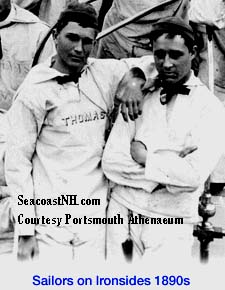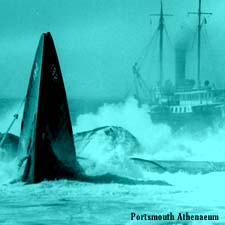|
FRESH STUFF DAILY |
|
|
||
|
|
||
|
|
||
|
SEE ALL SIGNED BOOKS by J. Dennis Robinson click here |
||
SEE: Early postcards of the Shipyard Around here people just call it "The Yard. " It was built on islands once used for drying fish. Today, more than 200 years old, the Portsmouth-Kittery Naval Shipyard is still pumping iron. Considered by many to be the nation's very first federal shipyard, PNS has weathered a turbulent transition from sail, to steam, to atomic fuel. Now dedicated to the overhaul and repair of modern submarines, "The Yard" has two centuries of stories to tell. George Washington visited the spot of the future federal shipyard during his visit in 1789. Yet officially, PNS was created on June 17, 1800. Under President Thomas Jefferson, the fledgling United States purchased two islands in the Piscataqua. This was the best spot on the New England coastline, according to the new Navy Department, to built American warships. The bad news: the rocky harbor was subject to fog, possessed a very rapid current and could be navigated safely only at high tide. The good news: the area was close to the sea, yet could be heavily fortified on both the New Hampshire and Maine sides. Even better, Fernald's and Dennett's islands off Kittery cost only $5,500.
In fact, The Falkland, commissioned here in 1690 for His Majesty's Royal Navy is considered the first British warship built in the colonies. That honor fell to the Piscataqua because it was, at that time, heavily forested with trees ideal for masts and planking. Indeed, it was for the trees and fish that John Smith, one of the most famous New World mariners of all time, suggested settling this region during his visit in 1614. It was the impending War of 1812 with England that sparked the building of navy yards here and elsewhere. The first ship built at the yard was named Washington, but was not launched until 1815. Yet by this time Piscataqua shipbuilders had already distinguished themselves in the American Revolution. Piscataqua builders were called on four more times to construct warships for the Continental Navy, among them the sloop Portsmouth and the frigate Congress, both launched before the sale of the federal navy yard in 1800. Congress was a sister ship to the famous Constellation, Philadelphia and Constitution contracted to other early American shipyards. Ironically, the man who became famous as commander of the Constitution, Admiral Isaac Hull, was in charge when enemy cannon balls bounced off "Old Ironsides" in the War of 1812. The very next year, Hull was placed in command of PNS. Ironsides herself was at Portsmouth Yard in the 1850s for a refit. Photographs of the Constitution here are among the very first images in the U.S. Naval Archives.
High-tech in the Civil War era meant the evolution of steam powered battleships, the arrival of the railroad, research into submersible and ironclad vessels and the construction of a massive "floating drydock." The Kearsarge, best known of the Portsmouth-built vessels from this time, was half-steamboat, half-sailing ship. Its defeat of the Confederate ship Alabama, said to have attacked 65 "Yankee" vessels, was a key battle in maritime history. Then, as now, The Yard defended itself against civilian attacks and threatened base closures. As the nation geared up for civil war, New Hampshire Senator John P. Hale waged a very public battle against what he considered spiraling graft and inflated military expenses at PNS. The 20th century arrived with a bang. Henderson's Point blew up on July 22, 1905 in what was then the largest dynamite explosion of all time. The explosion and dredging made the harbor viable for a whole new breed of underwater warships. That same year Portsmouth became a synonym for "peace" when the long tragic conflict between Russia and Japan ended here. Today the Navy Yard, the Rockingham and Wentworth-by-the-Sea hotels are important historic sites for visiting Japanese tourists interested in the Treaty of Portsmouth. A few years later, with the completion of the enormous military jail at PNS, Portsmouth also became a synonym for "prison." Housing a maximum of 3,000 military prisoners in WWII, the deactivated building still hunkers at the end of the island like a fantasy castle. The Jack Nicholson film "Last Detail" is the story of one convicted man on a journey toward "the worst place on earth." In April 1917 the first submarine built at a naval shipyard was launched at Portsmouth Harbor. Named simply L-8, it was the first and only submarine to serve in World War 1. During the war things were changing at PNS too. Photographs show an increasing population of women working as yeoman, and in a wide-range of manufacturing jobs. At this time New Hampshire shipyard workers, male and female were still commuting across the river to the yard by ferry. That changed in 1923 when a memorial bridge, dedicated to those lost in WWI, finally created a connecting roadway between the neighboring states. A 5-year-old girl named Eileen Dondero, whose mother would become the city's first woman mayor, was on hand to cut the ribbon, opening interstate traffic. That girl too grew up to become mayor of Portsmouth, and an ally of the naval shipyard. Through both world wars, PNS production was unsurpassed by any other naval submarine facility. Theodore Roosevelt stopped by aboard the presidential yacht for a friendly inspection. Three years later, in 1943, Portsmouth set a record with four launchings in a single day. The durable sub Sand Lance took 100 Japanese depth charges and survived to fight again. In 1945, Seacoast residents spotted German U boats in the Piscataqua. A number of Nazi subs arrived here to surrender and, as the war ground to a conclusion, many Seacoast citizens got a close look at the enemy for the first time. War ended, even as war technology escalated. The age of atomic-powered submarines arrived, epitomized in the early 1950s by the un-armed research vessel Albacore. The plucky new teardrop design was fully submersible, set new underwater speed records and redefined the shape of things to come for modern submarines. Then came Thresher. In 1963 the newly designed submarine was lost at sea in 8,400 feet of water with 129 souls aboard. One-hundred forty nine children were left fatherless by the greatest tragedy in local history. Another Sand Lance had the distinction in 1969 of being the last of 134 subs built at the Portsmouth-Kittery Navy Yard. Then, with the fear of base closure hovering like a New England storm front, PNS set about the job of reinventing itself once more. Now a recognized leader in repair of nuclear-powered submarines, the base has down-sized to half of what was an 8,000 member work force. And so the turbulent ride continues. In a time of tightly-watched military expenditure, the concept of "outleasing" has kept PNS business alive in partnership with private companies. Commercial use of the naval prison building are being explored, but security has been tight since the tragedy of 9/11. New Hampshire and Maine continued to wage a legal battle over which state the navy yard is actually located in, but the Supreme Court recently settled that score. "The Yard" is definitely in Maine. The border controversy that began in the days of British rule is finally over. Despite the squabbles, locals remain proud of a shipbuilding tradition that spans five centuries -- and just sails on. Copyright © 2000 by J. Dennis Robinson. Updated in 2005. Please visit these SeacoastNH.com ad partners.
News about Portsmouth from Fosters.com |
| Saturday, April 20, 2024 |


|
Copyright ® 1996-2020 SeacoastNH.com. All rights reserved. Privacy Statement
Site maintained by ad-cetera graphics

 The Shipyard
The Shipyard



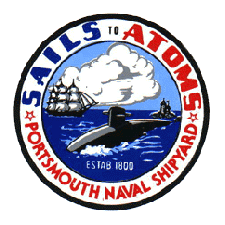
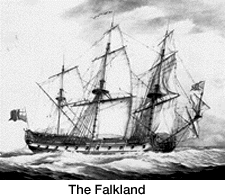 Another Piscataqua advantage, according to the official 1798 government report, was the abundance of skilled craftsmen already living in the area. That's because Piscataqua shipbuilders had already been making warships for the government for over a century the English king, that is.
Another Piscataqua advantage, according to the official 1798 government report, was the abundance of skilled craftsmen already living in the area. That's because Piscataqua shipbuilders had already been making warships for the government for over a century the English king, that is.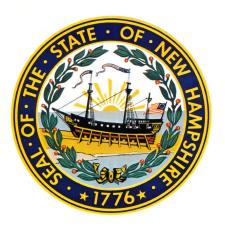 The Raleigh, built in just 60 days
The Raleigh, built in just 60 days 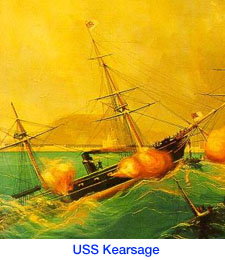 The rise and fall of shipyard activity were tied to the nation's war efforts and appropriation of federal funds. From the Civil War, Spanish-American War, two world wars through the Cold War, PNS production rose and fell like a tall ship on a heavy sea, towing the local economy in its wake. Set on what were once rocky islands where locals collected wild berries, PNS grew and evolved through the 19th century into a serious federal facility. Luxurious officer's quarters and modern housing for enlisted men sprang up and large buildings identified only by numbers dotted the landscape. The gigantic Franklin Building, built in 1828 was the largest shipbuilding structure anywhere.
The rise and fall of shipyard activity were tied to the nation's war efforts and appropriation of federal funds. From the Civil War, Spanish-American War, two world wars through the Cold War, PNS production rose and fell like a tall ship on a heavy sea, towing the local economy in its wake. Set on what were once rocky islands where locals collected wild berries, PNS grew and evolved through the 19th century into a serious federal facility. Luxurious officer's quarters and modern housing for enlisted men sprang up and large buildings identified only by numbers dotted the landscape. The gigantic Franklin Building, built in 1828 was the largest shipbuilding structure anywhere.